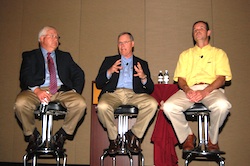 A very engaging session during the 2011 Swine Health Seminar hosted by Boehringer Ingelheim was the practitioner panel focusing on Emerging PRDC Control Opportunities. It came as no surprise that PRRS, or Porcine Reproductive and Respiratory Syndrome, was a hot topic among the attendees. The three panel experts include veterinarians Mike Eisenmenger with Swine Vet Center, Tom Gillespie with Rensselaer Swine Services and Randy Jones with Livestock Vet Services.
A very engaging session during the 2011 Swine Health Seminar hosted by Boehringer Ingelheim was the practitioner panel focusing on Emerging PRDC Control Opportunities. It came as no surprise that PRRS, or Porcine Reproductive and Respiratory Syndrome, was a hot topic among the attendees. The three panel experts include veterinarians Mike Eisenmenger with Swine Vet Center, Tom Gillespie with Rensselaer Swine Services and Randy Jones with Livestock Vet Services.
 Randy Jones is located in Eastern North Carolina and practices in a very pig dense area and PRRS is the number one disease that he deals with. He said it is a very frustrating disease to deal with from a control perspective. I asked him about the cycle of PRRS and he said that his area had been dealing with it, then circa virus came along and overwhelmed PRRS and to some extent it was forgotten about. Then once a vaccine became available for circa virus and they were so effective in protecting the pig that now they’re back fighting the same diseases again such as PRRS.
Randy Jones is located in Eastern North Carolina and practices in a very pig dense area and PRRS is the number one disease that he deals with. He said it is a very frustrating disease to deal with from a control perspective. I asked him about the cycle of PRRS and he said that his area had been dealing with it, then circa virus came along and overwhelmed PRRS and to some extent it was forgotten about. Then once a vaccine became available for circa virus and they were so effective in protecting the pig that now they’re back fighting the same diseases again such as PRRS.
Jones also noted that because viruses change and mutate they are hard to control so diagnostics is key. “The core of our program is diagnostics. You’ve got to do diagnostics to know what you’ve got, when you’ve got it. Because the timing makes all the difference in the in world in what type of control program you put in place.”
You can learn more about PRRS diagnostics in my full interview with Randy Jones here: Randy Jones Discusses The Role of Diagnostics in PRRS
Mike Eisenmenger practices in St. Peter, Minnesota but travels throughout the upper Midwest and like Jones, PRRS is the most prevalent disease he sees. He notes its a very smart virus and it stays one step ahead of the industry’s control programs. However, he believes that in general, they have been able to develop methods to manage sow  farms where they’ve been able to consistently make negative pigs even though the sow farm would be considered positive for the virus.
farms where they’ve been able to consistently make negative pigs even though the sow farm would be considered positive for the virus.
Also, like Jones, Eisenmenger promotes consistent diagnostics strategies and he stresses that pigs need to be tested frequently, for example at least one a month. If the pigs are negative, then he suggests vaccinating them shortly after weaning them with the PRRS virus. Then after they are sent off to go live in the “real world” tissue samples can be done to test to see if they continue to be PRRS negative. Should a finishing site become infected with PRRS, Eisenmenger said there are strategies, such as antibiotics, that can be taken, to mitigate the problem. If not treated, pigs will become much more susceptible to other bacterial diseases.
You can learn more about PRRS diagnostics, and control and mitigation strategies in my full interview with Mike Eisenmenger here: Mike Eisenmenger Discusses All Things PRRS
Check out the 2011 BIVI Swine Health Seminar Photo Album.

